 Last month we posted about a stand-off between Chinese fishing vessels and Philippine Coast Guard ships at Scarborough Shoal in the South China Sea. Both nations claim sovereignty over the area. Even the island name is in contention. The Philipines refers to Scarborough Shoal as Panatag Shoal and Bajo de Masinloc, whereas the Chinese call it Huangyan Island and Minzhu Jiao. This week 32 Chinese vessels blockaded the shoal, barring local Philippine fishermen access to the fishing grounds. The the shoal is 472 nautical miles from the Chinese coast and 124 nautical miles from the Philippines province of Zambales.
Last month we posted about a stand-off between Chinese fishing vessels and Philippine Coast Guard ships at Scarborough Shoal in the South China Sea. Both nations claim sovereignty over the area. Even the island name is in contention. The Philipines refers to Scarborough Shoal as Panatag Shoal and Bajo de Masinloc, whereas the Chinese call it Huangyan Island and Minzhu Jiao. This week 32 Chinese vessels blockaded the shoal, barring local Philippine fishermen access to the fishing grounds. The the shoal is 472 nautical miles from the Chinese coast and 124 nautical miles from the Philippines province of Zambales.
In another move to assert sovereignty over disputed waters in the South China Sea, China’s first deep-water drilling rig began operations near islands in the South China Sea. Cnooc Ltd., China’s largest offshore oil producer, said its semi-submersible CNOOC 981 began drilling yesterday 199 miles southeast of Hong Kong at a depth of 1,500 meters in an area north of the Paracel islands claimed by China, Vietnam and Taiwan.
As reported by Bloomberg Business Week: Competition for energy reserves in the sea has increased tensions as countries shun joint development and improve their respective naval capabilities. Chinese vessels have confronted Vietnamese survey ships over the past year and have been locked in a monthlong standoff with Philippine boats over a disputed island in another area of the sea.
While thus far the disputes have remained within the region, the region, as the Philippines is a US ally there is the risk that the Unated States could be drawn into the conflict. Benjamin Carlson, writing in the Global Post asks: Is this Cold War 2.0?
This scuffle is merely one of dozens of overlapping, contradictory claims for territory in the South China Sea, where the nations of Southeast Asia are facing off against an increasingly assertive China — and against one another.
“China certainly shares much of the blame for the current standoff. Its claims to the South China Sea, based on limited historical evidence, do not provide a significant basis to make sweeping, unilateral assertions,” says Andrew Billo of the Asia Society.
Where does the US fit into this toxic brew of jingoism, nationalism, and disputed territory? Its strategic shift to the Pacific, geopolitical rivalry with China, and alliance with the Philippines have inescapably drawn American interests to the Asian hotspot.
In early May, Secretary of State Hillary Clinton outlined America’s emerging priorities in the South China Sea: freedom of navigation, unimpeded commerce, maintenance of peace and stability, and respect for international law.
Beyond that, the sea plays an enormously valuable role as the international highway of global trade. Half of all the world’s intercontinental goods pass through the South China Sea, amounting to $1.2 trillion in trade with the US every year, according to a January report from the Center for New American Security. And its untapped energy resources are vast: 900 trillion cubic feet of natural gas, and as much as 130 billion barrels of oil are estimated to lie undiscovered beneath the seabed.
Recently the Christian Science Monitor argued that the UN Law of the Sea Treaty would help the US counter China’s aggressive moves to claim islands near the Philippines and other Asian neighbors. Senate Republicans have blocked ratification of the treaty which was negotiated by the previous Bush Administration.
Thanks to Phil Leon for contributing to this post.

I have an oil painting of Phillipine boats in a harbor, and the artist’s name is Carlson. Blue is the prediominate color with black boats and beige sails. Does this sound familiar? I can text a picture.